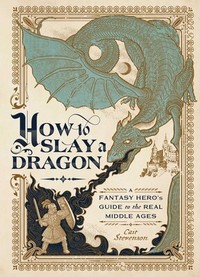 |
How to Slay a Dragon:
|

From the Back of the Book
I tried to come up with my own summary, and it kept coming out like those horrible paraphrases you turned in to your teacher after basically sitting down with an encyclopedia for ten minutes—technically not plagiarism (at least not to a sixth-grader’s mind), but not really original work.
Instead, let’s just see what the back of the book says:
Grab your magical sword and take the place of your favorite fantasy character with this fun and historically accurate how-to guide to solving epic quests.
What should you ask a magic mirror? How do you outwit a genie? Where should you dig for buried treasure? Fantasy media’s favorite clichés get new life from How to Slay a Dragon: A Fantasy Hero’s Guide to the Real Middle Ages, a historically accurate romp through the medieval world. Each entry presents a trope from video games, books, movies, or TV—such as saving the princess or training a wizard—as a problem for you to solve, as if you were the hero of your own fantasy quest. Through facts sourced from a rich foundation of medieval sources, you will learn how your magical problems were solved by people in the actual Middle Ages.
Divided into thematic subsections based on typical stages in a fantastical epic, and inclusive of race, gender, and continent, How to Slay a Dragon is perfect if you’re curious to learn more about the time period that inspired some of your favorite magical worlds or longing to know what it would be like to be the hero of your own mythical adventure.
So, what did I think about How to Slay a Dragon?
It’s a great concept—fantasy readers (and writers, I assume) are frequently talking about authenticity and if X technology or practice really fits with an era. Or how would you really go about doing Y? We’ve needed something like this book for years.
It’s just clever—it’s not just about the topics that Stevenson addresses, it’s how the topics are dealt with. There’s a great deal of wit in the setup and explanation of each one—and the way they flow from subtopic to subtopic. Jumping from person to person, location to location, and so on could seem erratic or jarring, but she makes it feel like it flows naturally.
I love her voice—I honestly wish I wrote the way Stevenson does. It’s not just the humor, it’s the way she approaches an idea. It’s the kind of prose that if I decided to get serious about writing that I’d want to study emulate.
Yet…this was one of those strange, I can’t explain it at all, the whole is less than the sum of its parts reads for me. It impressed me on all fronts, and yet I was bored almost the entire time. Until the last 40 pages or so, I’d eagerly pick it up and dive in, and then my mind would start wandering within a page or so.
It absolutely could be just what was going on for me this week, it’s likely just me—I fully expect after I post this and look around at what others say that I’m going to see a lot of raving. But I just can’t do that.
I’m sticking with the 3 stars because of the sum of its parts and because one of the first notes I made was, “if she keeps this up, she’s got a lock on 4+ stars.” Otherwise, this would be 2 stars.
By all means, fill up the comment section with ways I’m wrong about this one.

This post contains an affiliate link. If you purchase from it, I will get a small commission at no additional cost to you. As always, opinions are my own.
![]()


